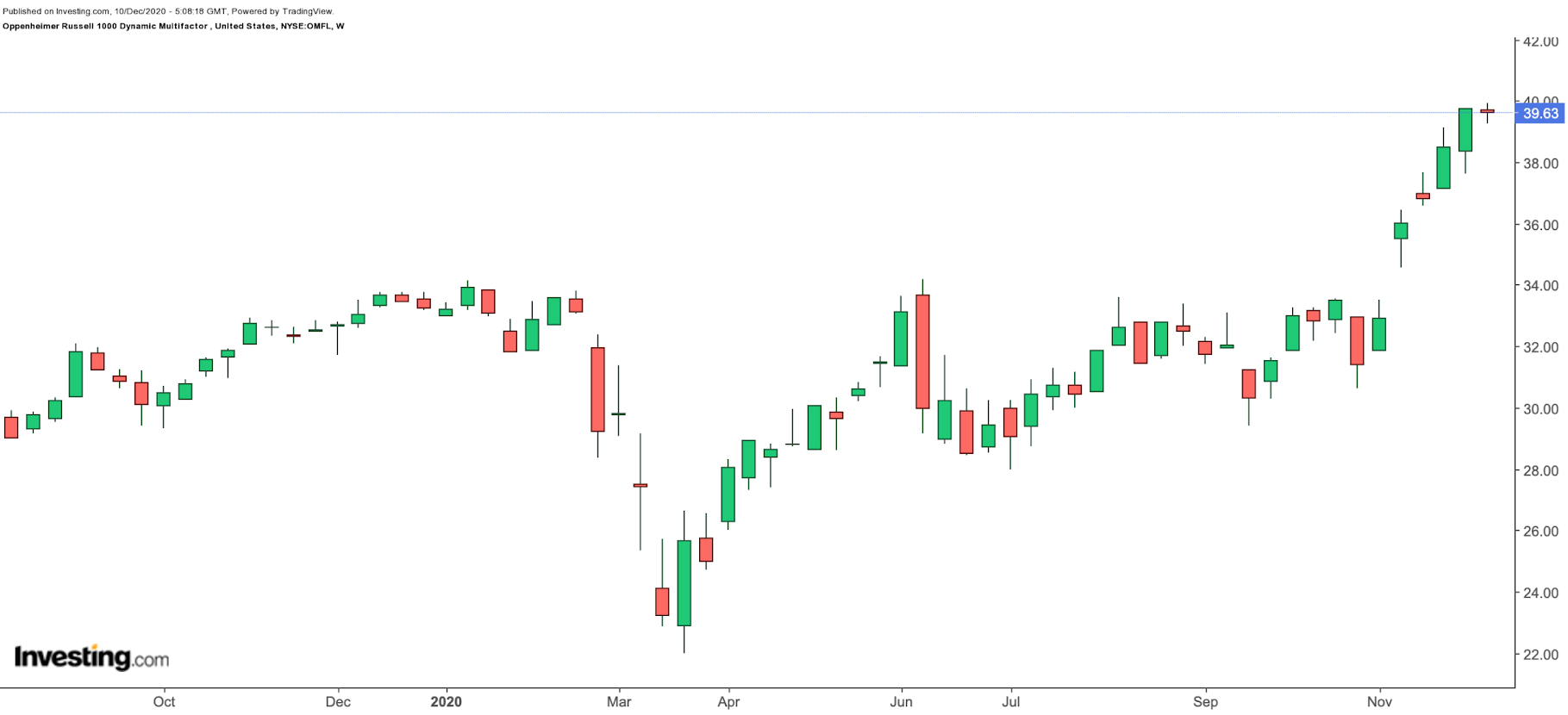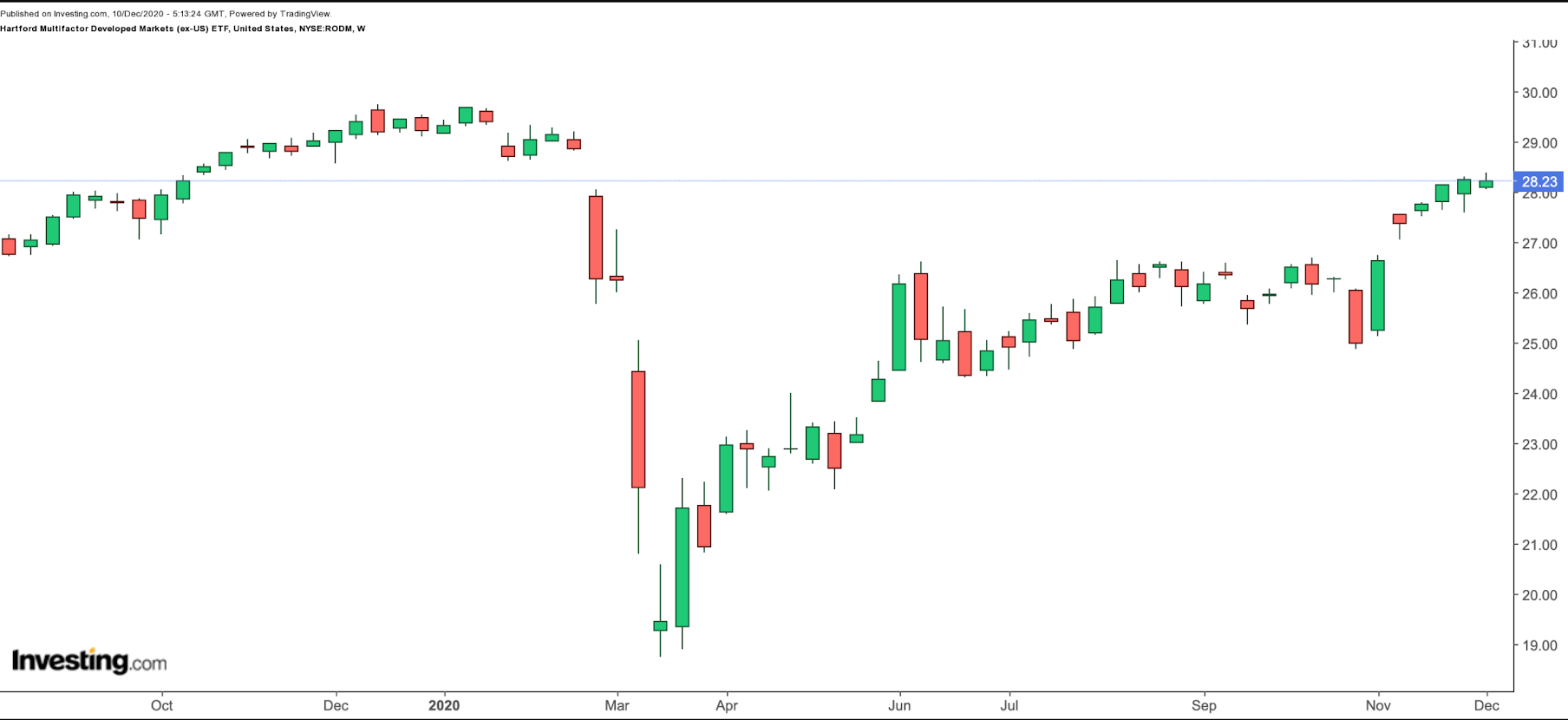Looking to diversify across asset classes, investment styles, or regions? Multifactor exchange-traded funds are worth considering.
There are around 300 multifactor exchange-traded funds listed in the US and the number is only likely to increase in the coming quarters.
Each multifactor uses its own unique criteria, giving different weighting to various factors, sectors, or countries.
MSCI (NYSE:MSCI), well-known for its diverse indices, explains that "a factor can be thought of as any characteristic relating a group of securities that is important in explaining their return and risk."
MSCI identifies six equity risk premia factors that historically provided a premium based on academic research including "Value, Low Size, Low Volatility, High Yield, Quality and Momentum." Investors considering a multifactor ETF should research the fund's factors carefully.
Below are 2 multifactor ETFs worth a look:
1. Invesco Russell 1000 Dynamic Multifactor ETF
- Current Price: $36.66
- 52-Week Range: $22.00-$39.93
- Dividend Yield: 1.48%
- Expense Ratio: 0.29%
The Invesco Russell 1000 Dynamic Multifactor ETF (NYSE:OMFL) provides exposure to a range of large-cap companies in the Russell 1000 index, which represents the top 1000 companies by market cap in the US. These stocks are selected according to market conditions and economic cycles (such as slowdown, contraction, recovery, or expansion).
Fund managers use proprietary tools to observe economic indicator signal changes. The five investment styles, or factors, utilized are value, momentum, quality, low volatility, and size.

OMFL, which has 346 holdings, tracks the Russell 1000 OFI Dynamic Multifactor Index. The index and the ETF are reconstituted and rebalanced as frequently as every month.
The fund started trading in November 2017. The top ten businesses make up around 7% of assets of 1.2 billion. Put another way, no single company is large enough to affect the fund's returns significantly by itself. 11 industry groups are represented in the fund, starting with financials (27.6%), followed by industrials (17.4%), consumer services (16.0%), consumer goods (11.9%), and basic materials (6.0%).
Global media and entertainment group Viacom (NASDAQ:VIAC), equipment rental giant United Rentals (NYSE:URI), healthcare services company Cardinal Health (NYSE:CAH), Delta Air Lines (NYSE:DAL) and IT firm Hewlett Packard Enterprise (NYSE:HPE) are the leading names in the ETF.
Year-to-date, OMFL is up close to 20% and hit an all-time high of $39.93 on Dec. 9. A potential short-term decline toward $37 would offer an improved margin of safety for long-term investors.
2. Hartford Multifactor Developed Markets (ex-US) ETF
- Current Price: $28.23
- 52-Week Range: $18.76-$29.74
- Dividend Yield: 2.68%
- Expense Ratio: 0.29%
The Hartford Multifactor Developed Markets (ex-US) ETF (NYSE:RODM) gives access to a range of firms in major developed markets of Europe, Canada and of the Pacific Region. Investment factors chosen by fund managers are low valuation (50%), high momentum (30%), and high quality (20%).

RODM, which tracks the Hartford Risk-Optimized Multifactor Developed Markets (ex US) Index, has 493 holdings. The fund started trading in February 2015 and net assets stand at $2 billion.
In terms of sector allocation, health care and financials have the highest weighting (15% each), followed by consumer staples (13%), industrials (12%), and consumer discretionary (10%) among others. The top names in the fund comprise around 7.5% of the assets.
Denmark-based health care group Novo Nordisk (NYSE:NVO) and Germany-headquartered life sciences business Merck (DE:MRCG), (OTC:MKKGY) are leading names in the fund. In addition, Sweden-based Investor (OTC:IVSBF) is also a top company in the RODM, which holds stakes in several listed and private companies, including other Swedish companies like industrial firms Atlas (NYSE:ATCO) and Copco (OTC:APLKY), technological pioneer ABB (NYSE:ABB), British-Swedish pharmaceutical firm AstraZeneca (NASDAQ:AZN), and telecommunications Ericsson Telefon (NASDAQ:ERIC). Other companies in RODM include: Canadian food retailer Loblaw (TSX:L) and Japanese communications group NTT Docomo (T:9437), (OTC:DCMYY).
Since the start of the year, the fund is down about 4%. Investors who are looking to add international exposure may want to keep the fund on their radar.
